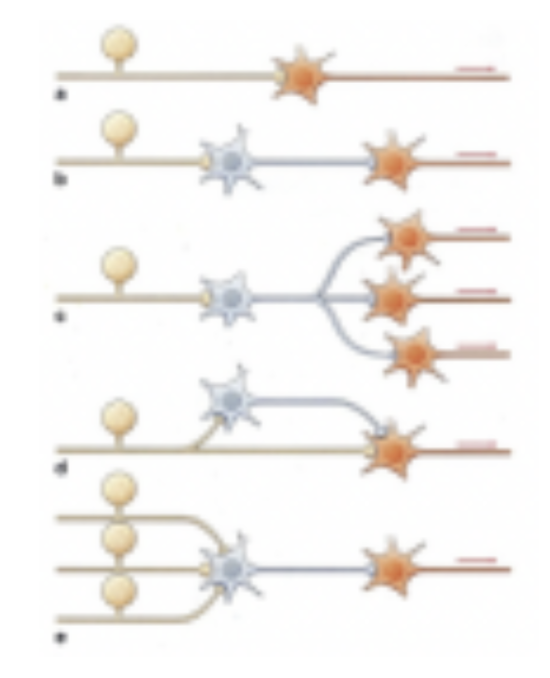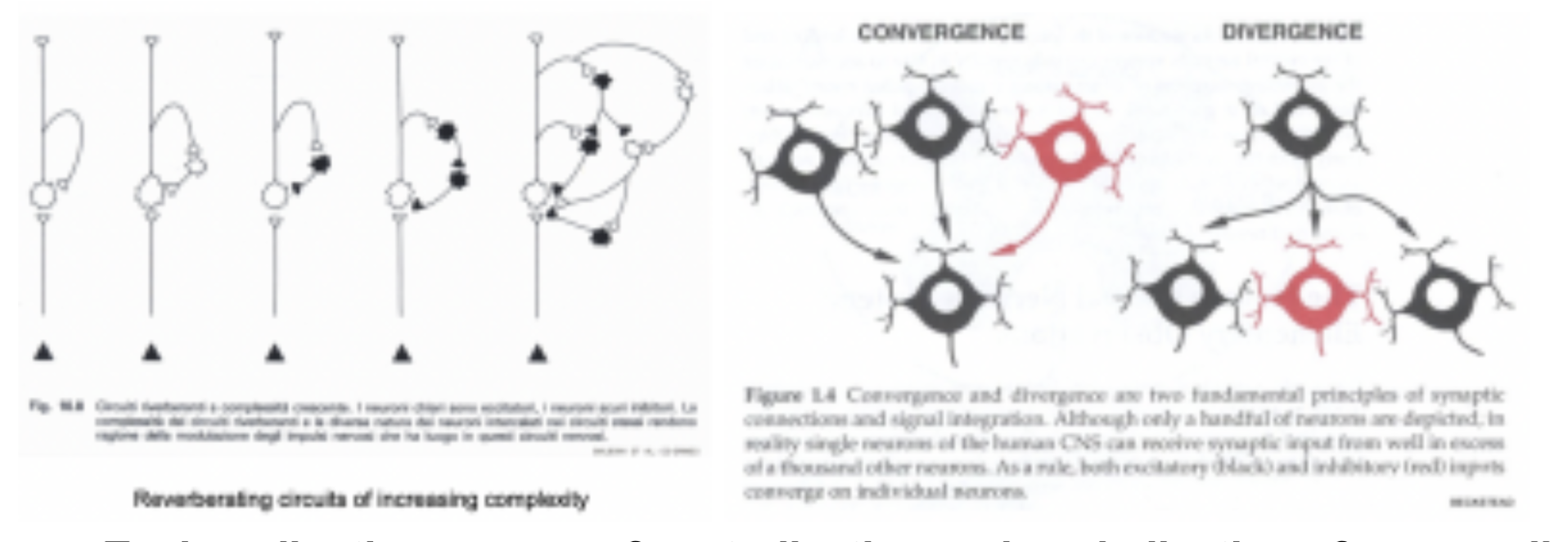Neuroanatomy 1 -- phylogenesis
1/26
There's no tags or description
Looks like no tags are added yet.
Name | Mastery | Learn | Test | Matching | Spaced |
|---|
No study sessions yet.
27 Terms
What is the need for a nervous system –
Evolutionary drive
Survival until reproduction
Survival of the individual & of the species
Sensing the environment and generating appropriate responses
What is special in a nerve cell? –
Perfected membrane excitability to better communicate – hyper-specialization
Drawback – Perennial cells, thus have problems with regeneration
The higher in the evolutionary ladder, the less replication/regenerational ability for nerve cells
Only in pluricellular organisms – Eumetazoans (animals with tissues)
Sponge nervous system
No nerve cells — since they are only made of one type of cells
Contractile/myoid elements because it has the ability to contract but this doesn’t mean it has a nervous system
Nerve cell evolution
Initially only myoid elements — ex. sponge
Then neural sensory elements appear — ex. sea anemone
Not motor — differentiate from epithelia covering the organism — connected to the contractile elements (to trigger motor response)
Then Effector nerve cells appear — motor elements that control the contraction of the myoid elements
3rd example of simplest nervous system based on a simple reflex arc — sensory element & motor response
Also sea anemone for ex.
Synapses appear
For communication between neurons or with myoid elements, and become more & more sophisticated —
Initially simple bidirectional electrical synapses, then become polarized with presynaptic neuron & postsynaptic element
Interneurons appear
Nerve cells with no contact to peripheral/outside motor elements — rather communicate & bridge sensory & motor elements
This allows for more complex behavior, with freedom to modify the outcome of a stimulus — freed from reflex arc
Formation of a diffuse network — visible in jellyfish
Organisms initially developed from sponges, then Cnidarians, where initial nerves are first developed (muscles for opening and closing mouth eventually)

Nervous system in a jellyfish — diffuse network
Organized around the feeding cavity as most of evolution is driven by feeding
(at the beginning of evolution most of the nerve cells are organised around the portion of the animal that digests food).
The layers of jellyfish are the most internal (the gastrodermis), the intermediate which is the mesoglea and the superficial layer. In blue there are the sensory elements and a network of fibres all throughout the mesoglea.
So, in other words, the nerve cells form a connecting network known as the nerve net throughout the width of the outer layer of cells, in an ECM called the mesoglea. The nerve net makes contact with the dermis, and the inner layer of cells, called the gastrodermis. These cells contain contractile fibres.
Synapses
Consists of a presynaptic neuron and postynaptic element
(Postsynaptic element could be neuron, muscle fiber, gland)
Chemical neurotransmitters
Sent across synapse, unidirectional
Could also find neuromodulators in the neuron that might modify a neurotransmitter’s effect
Initially were only electrical – simple synapses where membranes so close together that electrical signals spread – not sophisticated or efficient but present in our fetal life & development of nervous system
Interneurons
Interneurons allow the shift from the simple, direct, reflex arch to complex circuits
Can be inhibitory or excitatory
99% of the CNS neurons are interneurons – allow for a variety of transmissions
a. Simple direct transmission
b. Simple indirect transmission
c. Divergent transmission
d. Temporal redistribution
e. Convergence
Thus introduction of synaptic delay (minimal) between pre & post, due to presence of 2 synapses between sensory element & motor neuron
Presence of interneurons allows for very complex reverberating circuits
BASICALLY —
Left — somatic (sensory), right = motor, middle = CNS — basically saying can be different paths with different amounts of connections to each — different amount of delay per

Convergence & divergence
Convergence (e) and divergence (c) are two fundamental principles of synaptic connection and signal integration

How does nervous system further develop from jellyfish state
Currently, loosely organized system of nerve cells with no central control, mostly electrical synapses → bidirectional communication
Thus, stimulation at any point spreads to cause movements of the entire body
Thus — centralization & cephalization
After these processes, there will be the enlargement of anterior ganglia, that receive impulses from the sensory organs and that control feeding, which will give rise to the first brains
Centralization
There begins an increase of clustering of cells into ganglia (to control more complex motor tasks involving coordination — ex. swimming) — initially everywhere, but then begin to get closer to the central axis via centralization
Cephalization
As centralization occurs, there also is an increase in polarization, as these forming ganglia move to one pole via cephalization — resulting in the concentration of sensory organs & feeding structures in the head (or the forwards moving portion of the animal)
They migrate there because there is the feeding apparatus of the organism, which is very important to control the development of sensory organs — thus needing more neurons
More evident in bilateral animals – tends to be more active, requiring sense organs and feeding structures – the more complex, the more pronounced cephalization
Body symmetry
Very important to how an organism's nervous system will evolve (ex. Lead to process of cephalization) –
Asymmetrical, radial, or bilateral
Concentration of sensory organs on the head is useful because —
Functions to provide for rapid communication with the brain
Metazoans & protozoans
Metozoans —
Body composed of cells differentiated into tissues and organs, usually with a digestive cavity lined by specialized cells.
Protozoans —
Unicellular
When do we start seeing clear cephalization
The flatworm — large number of neurons in the rostral region & ladder-like organization of remainder of nervous system
Have “primordial eyes” — can detect more or less light
Huge step in evolution — allowing for knowledge of whether day or night
Annelid nervous system
Very well defined nerve core with brain anteriorly — a large ganglionated structure —
Although concentrated anteriorly, there is still ganglia in each segment controlling its movement
Humans can’t do this as we aren’t segmented & can’t control each segment
Begins to explain idea of why CNS & PNS needed
Octopus nervous system
Most sophisticated invertebrate nervous system — good CNS PNS relationship —
It has a brain-like structure but only part of this NS is localised in the brain, the rest is in the tentacles of this animal.
Octopus arms show a variety of complex reflex actions that persist even when they have no input from the brain. Octopus can move, learn and strategically decide what to do.
Evolution of nervous system in vertebrates — what happens after centralization & cephalization?
Formation of tubular nervous system & brain vesicles — appears in chordates & vertebrates
During process of gastrulation (neurulation) – formation of neural tube (Our NS = tubular NS)
Occurs with a series of swellings (vesicles) in the anterior end of the nervous cord (will become the spinal cord)
This spinal cord is protected by vertebrae and connected to the periphery by a two-way pathway
Fibers in the spinal cord are segregated into ascending sensory pathways and descending motor pathways
Nervous system of vertebrates
The archetype of the vertebrate CNS is the amphioxus, a branchiostoma. The tubular CNS is located dorsally. In the amphioxus we can start to see the organisation of the tubular nervous system and how the CNS is connected to the periphery through the PNS.
The NS of vertebrates is composed of a central nervous system and a peripheral nervous system.
Segmenting the nervous system
In amphioxus — no overt segmental compartments of the brain, while in gnathostomes (vertebrates with jaws) the NS is divided into several domains — formation of vesicles
This segmentation into vesicles occurs due to presence of genes — each portion of the rostral vesicle with a specific gene will become a specific part of the future brain

The brain vesicles
The bulge-like features of the early development of the neural tube in vertebrates
Simplest vertebrates — 2 vesicles
More complex vertebrates — 5 vesicles
Ex. mammals
In humans, initially 3, then become 5
Progressively in mammals 2 important portions of the brain appear —
Neocerebellum
Neocortex
Cerebellum
An organ found in the posterior cranial fossa associated to the brain stem
Very important for motor control
Divided into 3 phylogenetically distinct regions —
Archicerebellum
Paleocerebellum
Neocerebellum (appearence starts in mammals)
Gyrification
Important evolutionary step due to the hugely increased amount of neurons in the rostral parts of these vesicles
The surface of a human brain has a lot of circumvolutions (it isn’t smooth). Gyrification is the process by which this is achieved from a smooth surface —
The brain undergoes changes in surface morphology to create sulcal and gyral
regions. We have more neurons in the cerebral cortex, and consequently the surface of the brain becomes more convoluted and less smooth.
Is it only a question of size?
No — elephant or whale brain is larger than ours but they are not as “smart” — because of the microcircuitry — how these neurons are organized & connected to one another
In a human & in a mouse, when looking at areas with similar functions of the cortex, in humans there are a lot of dendritic spines with many synaptic devices — much more spines than in mice
Migration of primary sensory neurons outside of the CNS
An important evolutionary step — in humans the primary sensory neurons (pseudo unipolar neurons) are in ganglia in the PNS, but in early vertebrates they were inside the CNS — thus they migrated out
Vertical arches of increasing complexity
An important evolutionary step — Originally the reflex arches are mostly segmental, at the same level, with information entering at one level of the axis of the NS and exiting at the same level — however, as the NS progresses, we have vertical ascending & descending arches of increasing complexity
During evolution of vertebrate brain — first brain is reptilian, mainly fighting and mating — then limbic (old mammilian), related to the ability to show affection & socialize — then neocortex of the neomammalian brain, with more complex function ability & information processing
MAKE SURE TO REVIEW NEURON HISTOLOY!!